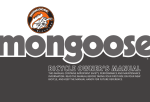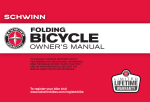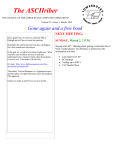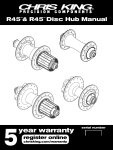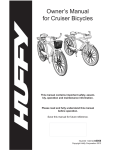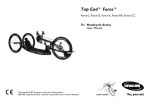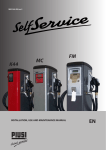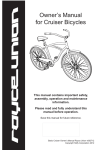Download Huffy M0073 User's Manual
Transcript
Owner’s Manual for Multi-Speed Comfort Bicycles This manual contains important safety, assembly, operation and maintenance information. Please read and fully understand this manual before operation. Save this manual for future reference. HComfort EN 071913 m0073 Copyright Huffy Corporation 2013 Owner’s Manual Index Introduction • Owner’s Bicycle Identification Record ................................................... 3 • Fitting the Rider to the Bicycle ............................................................... 3 • Warning and Safety Information ............................................................ 4 • Reflectors .............................................................................................. 4 • Rules of the Road .................................................................................4/5 • The Owner’s Responsibility ................................................................... 5 Components • Part Assembly View ............................................................................... 6 • Parts Assembly List ............................................................................... 7 Assembly • Introduction ............................................................................................ 8 • Tools Needed ......................................................................................... 8 • Front Fender Install ............................................................................... 9 • Assemble the Front Wheel to the Fork ................................................. 11 • Re-attach Front Brake Cable: ............................................................... 12 • Rear Fender Install ............................................................................... 13 • Handlebar and Stem Install .................................................................. 14 • Testing Stem and Handlebar Tightness ................................................ 16 • Seat Installation .................................................................................... 17 • Tightening Seat Quick Release Lever .................................................. 18 • Testing Seat Clamp and Post Clamp Tightness ................................... 19 • Front / Rear Reflector Installation ......................................................... 20 • Pedal Installation .................................................................................. 21 Maintenance and Service • Repair, Service and Adjustment ........................................................... 22 • Adjustable Luggage Rack..................................................................... 22 • Tires ..................................................................................................... 23 • Brake System ....................................................................................... 24 • Final Brake Adjustment Before Riding .................................................. 25 • Shift System ......................................................................................... 28 • Rear Derailleur Adjustments ................................................................. 30 • Inspection of the Bearings .................................................................... 32 • Lubrication / Lubrication Table .............................................................. 33 Warranty • Huffy Corporation Limited Warranty ...................................................34/35 2 Owner’s Bicycle Identification Record NOTE: This information is only available on the bicycle itself. It is not available from Huffy. Introduction Each Huffy bicycle has a Serial Number stamped into the frame. The Serial Number (1) can be found on the bottom of the crank housing as shown. xxx xx x 1 xx Write this number below to keep it for future reference. If the bicycle is stolen, give this number and a description of the bicycle to the police. This will help them find the bicycle. Model / Serial Number: Purchase Date: Model Name: Fitting the Rider to the Bicycle 1 3 2 To determine the correct size of bicycle for the rider: • Straddle the assembled bicycle with feet shoulder width apart and flat on the ground. • There must be at least 1 inch (2.5 cm) of clearance (1) between the highest part of the top tube (2) and the crotch of the rider with tires properly inflated. • The minimum leg-length for the rider is the highest part of the top tube plus one inch (3). 3 Warning and Safety Information Introduction Meanings of Warnings: a This symbol is important. See the word “CAUTION” or “WARNING” which follows it. The word “CAUTION” is before mechanical instructions. If you do not obey these instructions, mechanical damage or failure of a part of the bicycle can occur. The word “WARNING” is before personal safety instructions. If you do not obey these instructions, injury to the rider or to others can occur. • • • • • Do not add a motor to the product. Do not tow or push the product. Do not modify the product. Replace worn or broken parts immediately. If anything does not operate properly, discontinue use. Reflectors WARNING: For your own safety, do not ride the bicycle if the reflectors are incorrectly installed, damaged, or missing. Make sure the front and rear reflectors are vertical. Do not allow the visibility of the reflectors to be blocked by clothing or other articles. Dirty reflectors do not work well. Clean the reflectors, as necessary, with soap and a damp cloth. Rules of the Road WARNING: Failure of the rider to obey the following “Rules of the Road” can result in injury to the rider or to others. • Obey all traffic regulations, signs, and signals. • Always wear a bicycle helmet that meets safety standards, as well as local safety standards. • Ride on the correct side of the road, in a single file, and in a straight line. • If possible, avoid riding at night, dusk, dawn and any other time of poor visibility. • If you must ride at night or at time of poor visibility: • Purchase, install, and use a headlight and taillight. • Headlights are required by all states for nighttime riding and taillights are required in some states. • Battery-powered lights or flashing safety lights are also recommended. • Make sure the reflectors of your bicycle are correctly positioned. Do not remove the reflector or replace the reflectors with lighted devices that look similar to reflectors. 4 Rules of the Road - continued Introduction • Make yourself more visible to motorists: • Wear light-colored or reflective clothing, such as a reflective vest and reflective bands for your arms and legs. • Use reflective tape on your helmet. • Do not let anything cover the reflectors. • Use extra caution in wet weather: • Ride slowly on damp surfaces because the tires will slide more easily. • Avoid these hazards to prevent loss of control or damage to your wheels: • Be aware of drain grates, soft road edges, gravel or sand, pot holes or ruts, wet leaves, or uneven paving. • Cross railroad tracks at a right angle to prevent the loss of control. • Avoid unsafe actions while riding. • Do not carry any passengers. • Do not carry any items or attach anything to your bicycle that could hinder your vision, hearing, or control. • Do not ride with both hands off the handlebar. • Do not add a motor to the product. • Do not tow or push the product. • Do not modify the product. • Replace worn or broken parts immediately. • If anything does not operate properly, discontinue use. The Owner’s Responsibility WARNING: This bicycle is made to be ridden by one rider at a time for general transportation and recreational use. It is not made to withstand the abuse of stunting and jumping. If the bicycle was purchased unassembled, it is the owner’s responsibility to follow all assembly and adjustment instructions exactly as written in this manual, and any “Special Instructions” supplied and to make sure all fasteners and components are securely tightened. NOTE: Periodically check that all fasteners and components are securely tightened. If the bicycle was purchased assembled, it is the owner’s responsibility, before riding the bicycle for the first time, to make sure the bicycle has been assembled and adjusted exactly as written in this manual, and any “Special Instructions” supplied and to make sure all fasteners and components are securely tightened. NOTE: If product is assembled, please proceed to pages 16 and 19: Testing Stem, Handlebar and Seat Clamp tightness. 5 6 5 40 7 10 6 9 Components 29 22 23 11 16 37 18 39 15 33 34 14 30 19 28 1 20 27 13 24 35 25 26 31 12 17 36 32 7 5 6 10 3 21 38 9 2 22 23 4 8 Part Assembly View Description Frame Front Wheel Assembly Front Fender Wheel Retainer (x2) Axle Nut (x4) Washer (x4) Fender Brace Bolt (x4) Front Fender Mount Bolt Washer (x3) Nut (x2) Rear Fender Mount Bolt Handlebar Handlebar Stem Seat Quick Release Lever & Nut Rear Fender Front Reflector Rear Reflector (various models) Left Pedal Right Pedal Fork No. 1 2 3 4 5 6 7 8 9 10 11 12 13 14 15 16 17 18 19 20 21 Components 40 39 38 37 36 35 34 33 32 31 30 29 28 27 26 25 24 23 22 No. Rear Reflectors (x2) (various models) Derailleur Front Brake Rear Brake Right Brake Lever Left Brake Lever Seat Post Hardware Seat Post Head Set Chain guard Chain Rear Wheel Assembly Kickstand Shift Grip Crank Bearings Crank Set Grip Tube (x2) Tire (x2) Description Parts Assembly List 7 Introduction Assembly This Owner’s Manual is made for several different bicycles: • Some illustrations may vary slightly from the actual product. • Follow instructions completely. • If the bicycle has any parts that are not described in this manual, look for separate “Special Instructions” that are supplied with the bicycle. • Models may have different accessory items such as bags, baskets, reflectors, cup holders, racks, etc. • All features, components and accessories are not included on all models. • Use the Index page to locate specific sections of this manual. • Please read through this entire manual before beginning assembly or maintenance. WARNING: Keep small parts away from children during assembly. NOTE: All of the directions (right, left, front, rear, etc.) in this manual are as seen by the rider while seated on the bicycle. Do not dispose of the carton and packaging until you complete the assembly of the bicycle. This can prevent accidentally discarding parts of the bicycle. Tools Needed 8 Small Adjustable Wrench (Jaws must open at least 9/16 inch.) Open-end Wrenches Flat-blade Screwdriver Phillips Screwdriver Slip-Joint Pliers Metric Allen Wrenches Front Fender Install (various models) Loosen the Front Brakes: 1. Squeeze the two Brake arms together (A). 2. Lift out the Brake Cable Guide (B) from the Guide Bracket (C). C A Assembly B A C B Note: Turn Fork so that Brake Arms are toward front of bike. Use Screw Driver and Wrench: 1. Front fender attaching hardware has been pre-assembled onto the fork. Remove the Bolt (8) and Washer (9) and Nut (10) from the fork crown. 2. Remove lower mounting Bolts (7) and Washers (6) from the dropout before starting (fig 01). 8 9 10 6 7 fig 01 continued >> 9 Assembly Front Fender Install (various models) - continued 3. Place the Fender (3) in the fork with the longer fork mounting tab (A) on the rear side of the fork (fig 02). 4. Insert the Bolt (8) through the Washer (9) and Fender tabs and fork mounting hole. 5. Install Washer (9) and Nut (10) onto Bolt (8) and tighten securely. 9 8 10 9 A 3 fig fig01 02 6. Line up the lower Fender Braces (B) with the Fork Mounting Tabs (C) (fig 03). 7. Insert each lower mounting Bolt (7) and Washer (6) into the Fork Mounting Tabs (C) and tighten securely. 7 C B 6 10 fig 03 1. If the Axle Nuts (5) are already attached to the front wheel axle, begin by removing them with an open end wrench or adjustable wrench. 2. Set the wheel into the front fork (21) (fig 04). 3. Install wheel retainers (4) making sure the tabs are in the fork (D) tab holes. 4. Attach the front wheel with the Axle Nuts (5). 5. Tighten Axle Nuts to 21 ft-lbs. D 21 4 5 4 5 fig 04 Note: Ensure wheel spins freely without contacting fork or fender. WARNING: Do not use Nuts (5) without serrations to attach the front wheel. WARNING: Put the wheel in the center of the fork and tighten both nuts to the recommended torque of 21 ft.-lbs. WARNING: Failure to obey these steps can allow the front wheel to loosen while riding. This can cause injury to the rider or to others. continued >> 11 Assembly Assemble the Front Wheel to the Fork Front Wheel Install - Notes and Warnings: NOTE: Ensure wheel spins freely without contacting fork or fender. Assembly WARNING: Do not use Nuts (5) without serrations to attach the front wheel. WARNING: Failure to obey these steps can allow the front wheel to loosen while riding. This can cause injury to the rider or to others. Re-attach Front Brake Cable: Re-attach Front Brake Cable: 1. Squeeze the two Brake arms together (A). 2. Insert the Brake Cable Guide (B) into the cutout in the Guide Bracket (C). 3. Make sure the Brake Cable Guide (B) is seated securely in the Guide Bracket (C) cutout. WARNING: Check Front Brake Adjustment Before Riding! See Brakes Section Page 24 B C A C B 12 A Rear Fender Install (various models) Note: Top Fender mount is loose (fig 06) to allow installation. Assembly 1. Line up the Rear Fender Braces (A) with the Frame Mounting Tabs (B) (fig 05). 2. Insert each lower mounting Bolt (7) and Washer (6) into the Frame Mounting Tabs (B) and tighten securely. Make sure fender is centered over tire. B A B 6 7 fig 05 Tighten Top Fender Mount: 3. Tighten Bolt (11) and Nut (10) securely. Make sure fender is centered over tire (fig 06). 11 10 fig 06 Note: Ensure wheel spins freely without contacting frame or fender. 13 Assembly Handlebar and Stem Instal WARNING: To prevent steering system damage and possible loss of control, the “MIN-IN” (minimum insertion) mark (A) on the stem must be below the top of the Locknut (B). NOTE: Remove plastic Cap (E) from the end of the Stem (13). 1. Insert the Stem (13) into the fork (fig 07). 2. Point the Stem (13) towards the front of the bike. 3. Tighten the Stem Bolt (C) just enough to hold it in position. 4. If necessary, loosen the Handlebar Clamp Nut (D) and rotate Handlebar (12) into a comfortable riding position (fig 08). 5. Tighten Handlebar Clamp Nut (D) just enough to hold it in position (fig 08). 6. Align the stem (13) with the front tire and tighten the stem bolt (C) securely (fig 07). WARNING: Do not over tighten the stem bolt. Over tightening the stem bolt can damage the steering system and cause loss of control. C 13 A E B B A fig 07 One Bolt Stem (various models): • If necessary, re-adjust Handlebar (12) (fig 08). • Tighten Clamp Nut (D). NOTE: Do not over tighten. Torque to 17 ft-lbs. WARNING: If the handlebar clamp in not tight enough, the handlebar can slip in the stem. This can cause damage to the handlebar or stem, and can cause loss of control. 14 12 D fig 08 Handlebar and Stem Install - continued Two Bolt Stem (various models): 12 Assembly • If necessary, re-adjust Handlebar (12) (fig 08a). • Tighten Clamp Screws (D). D NOTE: Do not over tighten. Torque to 17 ft-lbs. WARNING: If the handlebar clamp in not tight enough, the handlebar can slip in the stem. This can cause damage to the handlebar or stem, and can cause loss of control. fig 08a 15 Testing Stem and Handlebar Tightness Assembly To test the tightness of the stem: • Straddle the front wheel between your legs. • Try to turn the front wheel by turning the handlebar. • If the handlebar and stem turn without turning the front wheel, realign the stem with the wheel and tighten the stem bolt(s) tighter than before (about 1/2 revolution only at a time). • Do this test again, until the handlebar and stem do not turn without turning the front wheel. To test the tightness of the handlebar clamp: • Hold the bicycle stationary and try to move the ends of the handlebar up and down. CAUTION: Do not exceed 100 lbs downward force. • If the handlebar moves, loosen the bolt(s) of the handlebar clamp. • Put the handlebar in the correct position and tighten the bolt(s) of the handlebar clamp tighter than before. • If the handlebar clamp has more than one bolt, tighten the bolts equally. • Do this test again, until the handlebar does not move in the handlebar clamp. Note: Exceeding 100 lbs downward force may damage the Threads of the Stem and Handlebar. If the Threads are damaged, the Handlebar will not stay in position when tightened. 16 Attach Seat to Seat Post (fig 09): (pre-assembled on some models) • Loosen nuts on Seat Clamp (A) and rotate Seat (14) into riding position. • Put the Seat Post (33) fully through the Seat Clamp. • Tighten the Seat Clamp so the Seat stays on the seat post. • If the Seat Clamp has a nut on each side, tighten both nuts equally. Assembly Seat Installation 14 A 33 fig 09 CAUTION: If you accidentally drop the seat post into the seat tube, it may be difficult to remove it. • Point the Seat forward and put the Seat Post into the Seat Tube (B) (figs 10, 11). WARNING: To prevent the seat coming loose and possible loss of control, the “MIN-IN” (minimum insertion) mark (C) on the seat post must be below the top of the Seat Tube. 14 C B 33 C B fig 10 continued >> 17 Assembly Tightening Seat Quick Release Lever Move the Quick Release Lever (D) to the “open” position so the word “open” is pointing away from the Seat Post Clamp (E). NOTE: The words “open” and “close” are on opposite sides of the quick release lever. 33 F B E D fig 11 CAUTION: Operate the Quick Release Lever by hand only. Do not use a hammer or any other tool to tighten the quick release lever. You must use strong force to move the quick release lever to the “close” position. If you can easily move the lever to the “close” position, the clamping force is too light. WARNING: If the clamping force of the Quick Release Lever is too light, the seat post can loosen while riding. This can cause injury to the rider or to others. Tighten the quick release lever (continued): • Open and close the Quick Release Lever with one hand while you turn the Adjusting Nut (F) with the other hand (fig 11). • Tighten or loosen the adjusting nut by hand, so that you first feel resistance to the quick release lever when it perpendicular to the bicycle frame. • Push the Quick Release Lever to the “close” position (fig 11). • When in the “close” position, make sure the Quick Release Lever lays against the Seat Post Clamp (E). • The tightening torque of the Quick Release Lever should be tight enough so that the seat does not move during normal operation. 18 Testing Seat Clamp and Post Clamp Tightness To test the tightness of the seat clamp and the post clamp: • Try to turn the seat side-to-side and to move the front of the seat up and down. • If the Seat (14) moves in the Seat Clamp (fig 10a): • • • • Assembly WARNING: Every time the quick release mechanism is loosened, make sure the red reflector is correctly positioned as shown in fig. 13 next page. Loosen the Seat Clamp (A). Put the seat in the correct position and tighten the Seat Clamp tighter than before. Do this test again, until the seat does not move in the Seat Clamp. If the Seat Post (33) moves in the Seat Tube (B): • • • • Move the Quick Release Lever (C) to the “open” position. Put the seat in the correct position and tighten the Quick Release Lever tighter than before. If necessary, loosen Quick Release Lever , tighten Adjusting Nut (D) and retighten Quick Release Lever . Do this test again, until the seat post does not move in the seat tube. 14 33 A C D B 19 Front / Rear Reflectors Installation (various models) Assembly Front Reflector Install: 1. Position Reflector (17) so it is near the Stem (A) and points straight forward (fig 12). 2. Tighten Clamp Screw. NOTE: Do not over-tighten. This will damage the Clamp. Make sure Reflector view is not obstructed. 17 A fig 12 Rear Reflector Install (various models): 1. Position Reflector (18) so it points straight backwards and is not above the seat post limit (A) (fig 13). 2. Tighten Clamp Screw. A NOTE: Do not over-tighten. This will damage the Clamp. Make sure Reflector view is not obstructed. 18 fig 13 Dual Rear Reflectors (various models): The Rear Reflectors (40) are pre-installed on the bike. Make sure they are secure, not bent and are pointing straight backwards. 40 20 Pedal Installation • The pedal marked “R” has right-hand threads. Tighten it in a clockwise direction. • The pedal marked “L” has left-hand threads. Tighten it in a counterclockwise direction (anti-clockwise). • Turn the right pedal marked “R” into the right side of the crank arm, and the left pedal marked “L” into the left side of the crank arm. Tighten the pedals (fig 14): • Make sure the threads of each pedal are fully into the crank arm. NOTE: The recommended torque (tightness) for each pedal is 30 ft.-lbs. L WARNING: Ensure pedals are secure in crank arms so they will not loosen. Periodically check tightness. R fig 14 Note: A Pedal Wrench is preferred for attaching Pedals. An open-end wrench can also be used as shown. 21 Assembly CAUTION: The right pedal is marked “R” and the left pedal is marked “L”. Repair, Service and Adjustment Maintenance WARNING: • Inspect the bicycle frequently. Failure to inspect the bicycle and to make repairs or adjustments, as necessary, can result in injury to the rider or to others. Make sure all parts are correctly assembled and adjusted as written in this manual and any “Special Instructions”. • Immediately replace any damaged, missing, or badly worn parts. • Make sure all fasteners are correctly tightened as written in this manual and any “Special Instructions”. Parts that are not tight enough can be lost or operate poorly. Over tightened parts can be damaged. Make sure any replacement fasteners are the correct size and type. NOTE: Have a bicycle service shop make any repairs or adjustments for which you do not have the correct tools or if the instructions in this manual or any “Special Instructions” are not sufficient for you. Luggage Rack Adjustment (various models) 1. Loosen Adjustment Knob (B) by turning counter clockwise. 2. Slide Adjustable Rack (A) into position 3. Tighten with Adjustment Knob by turning clockwise. NOTE: Do not over-tighten. This will damage the Knob. A 22 B Maintenance: • Frequently check the tire inflation pressure because all tires lose air slowly over time. For extended storage, keep the weight of the bicycle off the tires. • Do not use unregulated air hoses to inflate the inner tubes. An unregulated hose can suddenly over inflate bicycle tires and cause them to burst. • Replace worn tires. WARNING: Do not ride or sit on the bicycle if a tire is under inflated. This can damage the tire, inner tube or wheel. Inflating the Tires: • • • • Use a hand or a foot pump to inflate the tires. Service station meter-regulated air hoses are also acceptable. The maximum inflation pressure is shown on the tire sidewall. If two inflation pressures are on the tire sidewall, use the higher pressure for onroad riding and the lower pressure for off-road riding. • The lower pressure will provide better tire traction and a more comfortable ride. Before adding air to any tire, make sure the edge of the tire (the bead) is the same distance from the rim, all around the rim, on both sides of the tire. If the tire does not appear to be seated correctly, release air from the inner tube until you can push the bead of the tire into the rim where necessary. Add air slowly and stop frequently to check the tire seating and the pressure, until you reach the correct inflation pressure. See fig 17. fig 17 Tire Bead Seated Correctly Tire Bead NOT Seated Correctly 23 Maintenance Tires Brake System Maintenance NOTE: The front and rear brake adjustments are the same. WARNING: You must adjust the front and rear brakes before you ride the bicycle. Step 1: Put the brake shoes (B) in the correct position (fig 13): 1. Loosen the Screw (A) of each Brake Shoe (B). 2. Adjust each Brake Shoe so it is flat against the rim and aligned with the curve of the rim. 3. Make sure each Brake Shoe does not rub the tire. 4. If the surface of the Brake Shoe has arrows, make sure the arrows point toward the rear of the bicycle. 5. Hold each Brake Shoe in position and tighten the Screw. C B D A fig 13 Step 2: Test the tightness of each Brake Shoe: 1. Try to move each Brake Shoe out of position. 2. If a Brake Shoe moves, do Step 1 again, but tighten the nut tighter than before. 3. Do this test again, until each Brake Shoe does not move. continued >> 24 Step 3. Tightening the cable (fig 13): 1. Hold both Brake Shoes against the rim. 2. Loosen the cable clamp Screw (C). 3. Pull the Cable (D) tight and tighten the Screw. WARNING: Do not over tighten the cable clamp Screw. Over tightening the cable clamp Screw may cut the cable and cause injury to the rider or to others. Stretching the Cable: 4. Squeeze each brake lever firmly 20 times. 5. Hold both Brake Shoes against the rim and loosen the cable clamp Screw. 6. Pull the Cable tight and tighten the cable clamp Screw. Final Brake Adjustment Before Riding The following sections describe final brake system adjustments required before riding. Check tightness of the cantilever mounting Bolt (A) (fig 14): • Make sure each cantilever mounting Bolt is tightened securely. Center brake shoes on rim: 1. Turn the Adjustment Screw (B) on the cantilever arm to move the arm in or out so each Brake Shoe (C) is the same distance from the rim. 2. Squeeze the brake lever two times. 3. Do this step again, until both brake shoes are the same distance from the rim. fig 14 C A B continued >> 25 Maintenance Brake System - continued Brake System - continued Maintenance Put the brake shoes the correct distance from the rim (fig 15): 1. If desired, adjust Brake Levers (G) to a comfortable distance from the grip using the Adjustment Screw (H). Turning the screw IN brings it closer to the grip. 2. Make sure brake line Sheaths (A, B) are seated correctly. 3. Position each Brake Shoe 1/16 inch away from the rim: 4. Turn the caliper brake adjusting Screws (D) in or out to make the adjustment. 5. If the brake shoes cannot be positioned the correct distance from the rim, hold both Brake Shoes against the rim and loosen the cable clamp Screw (E) 6. Squeeze the Brake Arms (F) together and pull or loosen the cable wire slightly. 7. Tighten the cable clamp Screw. A E F C D 1/16” G 1/16” H B fig 15 continued >> 26 WARNING: Do not over tighten the cable clamp. Over tightening the cable clamp may cut the cable and cause injury to the rider or to others. 1. Repeat these steps until the brake shoes are 1/16 inch from the rim and the Brake Lever (G) does not go all the way to the grip when squeezed (fig 15). WARNING: Do not move the brake shoes away from a wheel rim that is not true (straight). This can cause the caliper brake to be less effective and unsafe. To allow safe adjustment of the caliper brake, have a bicycle service shop true the wheel. Test the tightness of the cable clamp (fig 15): 1. Squeeze each Brake Levers (G) with firm pressure. 2. Make sure the cable does not move in the Cable Clamp (E). 3. If the cable moves in the cable clamp, adjust the brakes again but tighten the cable clamp tighter than before. 4. Do this test again, until the cable does not move in the cable clamp. Test the travel of each brake lever: 1. Squeeze each Brake Lever (G) with strong pressure 2. If the brake lever touches the grip, adjust the brakes again. G WARNING: After you adjust the brakes again, if either brake lever touches the grip or does not work well, have a bicycle service shop repair or adjust the brakes. continued >> 27 Maintenance Brake System - continued Shift System Maintenance Note: Various models have different handlebar shifters and derailleurs, but the functions and instructions are the same. Parts of the Shift System: • Right-hand Shift Lever (A) operates the Rear Derailleur (B). • Rear Sprocket Set (C). C A B Operation: Operate the shift system as follows: 1. The rider turns the rear shift control around the handlebar (for twist shift models) or moves the shift lever (thumb shift models) to an index position 2. When the rear shift control moves into each position with a “click” sound, the shift is complete 3. The shift control pulls a cable wire that is attached to the rear derailleur. 4. The derailleur moves and guides the chain from one sprocket to another. 5. If there is some chain noise after the shift, turn the rear shift control a small amount to “trim” the rear derailleur. continued >> 28 Shift System - continued Maintenance CAUTION: Do not force the shift lever. Shift only when pedaling forward and without strong force. Do not backpedal. Backpedaling can cause the chain to come off the sprockets. Backpedaling and shifting while not pedaling can damage the sprockets and stretch the cable wire. There is no “correct gear” in which to ride the bicycle. The “correct gear” is the one that is comfortable to you. To select a gear while riding (this model has only one Front Sprocket (A)). 1. While pedaling, shift the chain onto different rear sprocket. 2. You will feel a difference in the rhythm and ease of pedaling. 3. Shift the chain to the gear that allows you to pedal at a rhythm and effort that is comfortable to you. 4. When riding uphill or against the wind, you may wish to shift the chain onto a larger rear sprocket (B). B A fig 16 continued >> 29 Maintenance Rear Derailleur Adjustments The rear derailleur has two adjusting screws. The “low” adjusting screw, sometimes marked “L”, limits how far the rear derailleur and chain can move toward the wheel. The “high” adjusting screw, sometimes marked “H”, limits how far the rear derailleur and chain can move away from the wheel. 1 2 3 4 5 6 A B fig 21 Put the “high” adjusting screw in the correct position as follows (fig 22): • Shift the chain onto the smallest rear sprocket. Loosen Nut (C) of the cable clamp. • Turn the lever Barrel Adjuster (A) and rear Derailleur Adjustor (B) all the way IN. • Turn the “high” adjusting Screw (G) so the Jockey Roller (D) is in line with the outside edge of the smallest rear Sprocket (E). • Remove the slack from the cable wire and tighten the Nut of the cable clamp. E D G F H C fig 22 continued >> 30 Rear Derailleur Adjustments - continued • Shift the chain onto the largest rear Sprocket (F). • Loosen Nut of the cable clamp. • Turn the “low” adjusting Screw (H) so the Jockey Roller is exactly below the largest rear sprocket. • Tighten the Nut of the cable clamp. Adjust the Index Shift System: • • • • Shift the chain onto the smallest rear sprocket. Without turning the crank, turn the Right Shift Control (A) one “click” rearward. Slowly turn the crank forward. The chain should move from the smallest rear sprocket to the next larger rear sprocket. • Turn the Adjusting Barrel (B) OUT as needed so the chain moves exactly on to the second rear sprocket and does not rub, jump, or delay. B A fig 23 When adjusted properly, the shift system will operate smoothly with no chain rubbing. Note: If you have trouble, take the bike to a bike shop. 31 Maintenance Put the “low” adjusting Screw in the correct position as follows (fig 22): Maintenance Inspection of the Bearings Maintenance Frequently check the bearings of the bicycle. Have a bicycle service shop lubricate the bearings once a year or any time they do not pass the following tests: Head Tube Bearings The fork should turn freely and smoothly at all times. With the front wheel off the ground, you should not be able to move the fork up, down, or side-to-side in the head tube. Crank Bearings The crank should turn freely and smoothly at all times and the front sprockets should not be loose on the crank. You should not be able to move the pedal end of the crank from side-to-side. Wheel Bearings Lift each end of the bicycle off the ground and slowly spin the raised wheel by hand. The bearings are correctly adjusted if: • The wheel spins freely and easily. • The weight of the spoke reflector, when you put it toward the front or rear of the bicycle, causes the wheel to spin back and forth several times. • There is no side-to-side movement at the wheel rim when you push it to the side with light force. 32 • • • • • • WARNING: Do not over lubricate. If oil gets on the wheel rims or the brake shoes, it will reduce brake performance and a longer distance to stop the bicycle will be necessary. Injury to the rider or to others can occur. The chain can throw excess oil onto the wheel rim. Wipe excess oil off the chain. Keep all oil off the surfaces of the pedals where your feet rest. Using soap and hot water, wash all oil off the wheel rims, the brake shoes, the pedals, and the tires. Rinse with clean water and dry completely before you ride the bicycle. Using a light machine oil (20W), lubricate the bicycle according to the following table: Lubrication Table What When How Pedals every six months Put four drops of oil where the axles go into the pedals. Chain every six months Put one drop of oil on each roller of the chain. Wipe all excess oil off the chain. Derailleurs every six months Put one drop of oil on each pivot point of the derailleurs. Brake Levers every six months Put one drop of oil on the pivot point of each brake lever. Cantilever Brakes every six months Put one drop of oil on the pivot point of each cantilever brake. Brake and cable every six months Put four drops of oil into both ends of each cable. Allow oil to soak back along the cable wire. Rear Sprocket Cluster every six months Lay the bicycle on its left side. Slowly turn the rear wheel clockwise. Put four drops of oil in the crack between the rear sprockets (which are stationary) and the freewheel body (which is turning clockwise). 33 Maintenance Lubrication Warranty Huffy Corporation Limited Warranty • Part or model specifications are subject to change without notice. • This Limited Warranty is the only warranty for your Huffy Corporation (“Huffy”) product. There are no other expressed or implied warranties. • This Limited Warranty extends only to the original consumer and is not transferable to anyone else. • Warranty registration is not required. • The only uses for this product are described in this manual. What does this Limited Warranty cover? This Limited Warranty covers all parts of the bicycle. What must you do to keep the Limited Warranty in effect? This Limited Warranty is effective only if: • Bicycle is completely and correctly assembled. • Bicycle is used under normal conditions for its intended purpose (see the following section for excluded activities). • Bicycle receives all necessary maintenance and adjustments. • Bicycle is used for general transportation and recreational use only. What is not covered by this Limited Warranty? • This Limited Warranty does not cover normal wear and tear, normal maintenance items, or any damage, failure, or loss that is caused by improper assembly, maintenance, adjustment, storage, or use of the bicycle. This Limited Warranty will be void if the bicycle is ever: • Used in any competitive sport • Used for stunt riding, jumping, aerobatics or similar activity • Installed with a motor or modified in any other way • Ridden by more than one person at a time • Rented • Used in a manner contrary to the instructions and warnings in this Owner’s Manual Huffy will not be liable for incidental or consequential loss or damage, due directly or indirectly from use of this product. Some states do not allow the exclusion or limitation of incidental or consequential damages, so the above limitation may not apply to you. 34 For how long does this Limited Warranty last? • The frame is warranted for life. • Aluminum frames are warranted for ten (10) years. • The fork is warranted for life except for shock and aluminum forks which are warranted for one (1) year. • Electronics are warranted for 90 days. • Batteries have no warranty • All other components are warranted for six (6) months. • All warranties are from date of purchase and for the original owner. What will Huffy do? Huffy will replace, without charge to you, the component found to be defective by Huffy. The original owner must pay all labor and transportation charges connected with the repair or warranty work. How do you get service? Contact Huffy Consumer Service. See included list for Customer Contact information. What rights do you have? This warranty gives you specific legal rights. You may also have other rights which vary from state to state. 35 Warranty Huffy Corporation Limited Warranty - continued WARNING: ALWAYS WEAR YOUR HELMET WHEN RIDING THIS PRODUCT! CORRECT INCORRECT • • • • • Helmet should sit level on your head and low on your forehead Adjust the strap sliders below the ear on both sides. Buckle the chin strap. Adjust strap until it is snug. No more than two fingers should fit between the strap and your chin. A proper fitting helmet should be comfortable and not rock forward/backward or side to side. • Always read the user manual that comes with your helmet to make sure it is fitted and attached properly to the wearer’s head according to the fitting instructions described in the user manual. Check www.Huffy.com for the current contact information H Helmet EN 100212 i0027




































